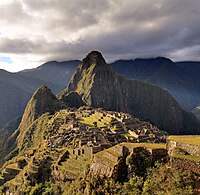Ayllu
 |
| Inca Empire |
|---|
Inca society |
Education · Religion · Mythology |
Architecture · Engineering · Roads |
Army · Agriculture · Cuisine |
Inca history |
Kingdom of Cusco · Inca Empire |
(Civil War · Spanish conquest) |
Neo-Inca State |
The ayllu is the traditional form of a community in the Andes, especially among Quechuas and Aymaras. They are an indigenous local government model across the Andes region of South America, particularly in Bolivia and Peru. Ayllus functioned prior to Inca conquest, during the Inca and Spanish colonial period, and continue to exist to the present day.[1] How the ancient form and current organization correspond is unclear, since Spanish chronicles do not give a precise definition of the term.[2]
Ayllus had defined territories and were essentially extended family or kin groups, but they could include non-related members, giving individual families more variation and security of the land that they farmed.[3] The male head of an ayllu is called a mallku which means, literally, condor, but is a title which can be roughly translated as "prince". They would often have their own wak'a, or minor god, usually embodied in a physical object such as a mountain or rock. "Ayullus were named for a particular person or place."[4]
Ayllu were self-sustaining units and would educate their own offspring and farm or trade for all the food they ate, except in cases of disaster such as El Niño years when they relied on the Inca storehouse system.[5] Their primary function was to solve subsistence issues, and issues of how to get along in family, and larger, units.[6]
Each ayllu owned a parcel of land, and the members had reciprocal obligations to each other.[7]
In marriages, the woman would generally join the class and ayllu of her partner as would her children, but would inherit her land from her parents and retain her membership in her birth ayllu. This is how most movements of people between ayllu occurred. But a person could also join an ayllu by assuming the responsibility of membership. This included mink'a, communal work for common purposes, ayni, or work in kind for other members of the ayllu, and mit'a, a form of taxation levied by the Inca government.[5]
“Ayllu solidarity is a combination of kinship and territorial ties, as well as symbolism. (Albo 1972; Duviols 1974; Tshopik 1951; and Urioste 1975). These studies, however, do not explain how the ayllu is a corporate whole, which includes social principles, verticality, and metaphor... Ayllu also refers to people who live in the same territory (llahta) and who feed the earth shrines of that territory.”[8]
Ayllu is a word in both the Quechua and Aymara languages referring to a network of families in a given area, often with a putative or fictive common ancestor.[1] Ayllus are distinguished by comparative self-sufficiency, commonly held territory, and relations of reciprocity.[1] Members engage in shared collective labor (Quechua: minga) and in reciprocal exchanges of assistance (Quechua: ayni).[9]
In Bolivia, representatives from the ayllus are sent to the National Council of Ayllus and Markas of Qullasuyu (Conamaq). This body chooses an Apu Mallku as its head.
Notes
^ abc Lewellen, Ted C. (2003). Political anthropology: An introduction. ABC-CLIO. pp. 38–39. ISBN 978-0-89789-891-1..mw-parser-output cite.citationfont-style:inherit.mw-parser-output qquotes:"""""""'""'".mw-parser-output code.cs1-codecolor:inherit;background:inherit;border:inherit;padding:inherit.mw-parser-output .cs1-lock-free abackground:url("//upload.wikimedia.org/wikipedia/commons/thumb/6/65/Lock-green.svg/9px-Lock-green.svg.png")no-repeat;background-position:right .1em center.mw-parser-output .cs1-lock-limited a,.mw-parser-output .cs1-lock-registration abackground:url("//upload.wikimedia.org/wikipedia/commons/thumb/d/d6/Lock-gray-alt-2.svg/9px-Lock-gray-alt-2.svg.png")no-repeat;background-position:right .1em center.mw-parser-output .cs1-lock-subscription abackground:url("//upload.wikimedia.org/wikipedia/commons/thumb/a/aa/Lock-red-alt-2.svg/9px-Lock-red-alt-2.svg.png")no-repeat;background-position:right .1em center.mw-parser-output .cs1-subscription,.mw-parser-output .cs1-registrationcolor:#555.mw-parser-output .cs1-subscription span,.mw-parser-output .cs1-registration spanborder-bottom:1px dotted;cursor:help.mw-parser-output .cs1-hidden-errordisplay:none;font-size:100%.mw-parser-output .cs1-visible-errorfont-size:100%.mw-parser-output .cs1-subscription,.mw-parser-output .cs1-registration,.mw-parser-output .cs1-formatfont-size:95%.mw-parser-output .cs1-kern-left,.mw-parser-output .cs1-kern-wl-leftpadding-left:0.2em.mw-parser-output .cs1-kern-right,.mw-parser-output .cs1-kern-wl-rightpadding-right:0.2em
^ Gordon F. McEwan, "Ayllu" in Encyclopedia of Latin American History and Culture, vol. 1, p. 248. New York: Charles Scribner's Sons 1996.
^ Beck, Roger B.; Linda Black; Larry S. Krieger; Phillip C. Naylor; Dahia Ibo Shabaka (1999). World History: Patterns of Interaction. Evanston, IL: McDougal Littell. ISBN 0-395-87274-X.
^ McEwan, "Ayllu", p. 248.
^ ab Incas: lords of gold and glory. New York: Time-Life Books. 1992. p. 64. ISBN 0-8094-9870-7.
^ Earle, Timothy K.; Johnson, Allen W. (1987). The evolution of human societies: from foraging group to agrarian state. Stanford, Calif: Stanford University Press. p. 263. ISBN 0-8047-1339-1.
^ Demarest, Arthur Andrew; Conrad, Geoffrey W. (1984). Religion and empire: the dynamics of Aztec and Inca expansionism. Cambridge, UK: Cambridge University Press. p. 97. ISBN 0-521-31896-3.
^ Bastien, Joseph. Mountain of the Condor: Metaphor and Ritual in an Andean Ayllu. 1978.
^ Bahr, Ann Marie B.; Martin E. Marty (March 2005). Indigenous religions. Infobase Publishing. pp. 135–36. ISBN 978-0-7910-8095-5.
Further reading
- Bastien, Joseph. Mountain of the Condor: Metaphor and Ritual in an Andean Ayllu. 1978.
- Godoy, R. 1986. The Fiscal Role of the Andean Ayllu. Man 21(4): 723-741.
- Rowe, John H. "Inca Culture at the Time of the Spanish Conquest" in Handbook of South American Indians, vol. 2. (1946)
External links
- Inca model
- Alessandro Vigiani (Università di Siena, Italia), Storia e attualità dell'ayllu nel contesto boliviano, "Achab. Rivista di Antropologia", n. 12, febbraio 2008, pp. 2-12